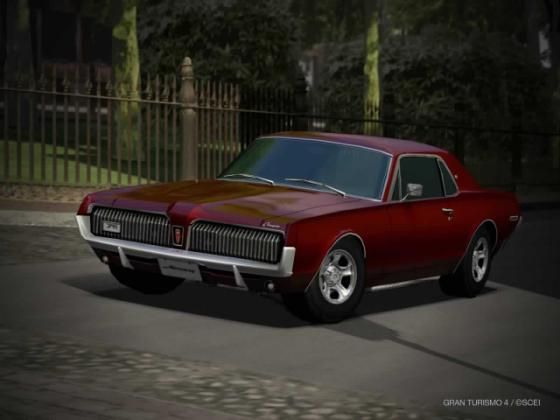|
SPEX
Year: 1967-1968
Class: Muscle Car / Pony Car
Type: 2-door hardtop coupe
Host: GT2 & GT4 ````````````````````````` Country: USA
Price: $12,000 (GT2) ,.. $16,547 (GT4 historic lot)
Length:
190.3" // Width: 71.2" // Height: 51.8"
Wheelbase: 111.0"
Overhang: @6 feet 7 inches
Track: ?
Ground Clearance:
6.3"
Body Construction: steel monocoque
Weight: 3,125 pounds
Layout: Front Engine / Rear Drive
Tires: 7.35 x
14"
F. Suspension: A-arms, coils, anti-roll bar
R. Suspension: live axle, leaf springs
Brakes: drum / drum
Engine: 390 cubic-inch OHV V8
Construction: iron block & heads
Aspiration: normal
Fuel System: 4-barrel carb
Valves / Cyl: 2
Bore x
Stroke: 4.05 x 3.78"
Compression: 10.5:1
`````````````````````````````GT2````````````````````````````GT4```````````
Horsepower: 328
@ 5,000 rpms 319 @ 4,800 rpm
Torque:
````````377 @ 4,000 rpms 427 @ 3,200
rpm
Credits per HP: ``$36.58
$51.87
Pounds / HP: 10.70
8.80
HP / Liter:
51.2
49.9
Idle Speed: 1,000 /// Redline: 5,600 /// RPM Limit: 6,000
3-speed manual or automatic (GT2)
4-speed
manual (GT4)
*specs below for GT4 Cougar
`````````````` from idle `````````` 2nd gear @ 5,600 rpm0-60 mph: 6.383 seconds 5.666 seconds 0-100mph: 13.116 seconds
12.416 seconds
400 M: 14.624 @ 106 mph
1 KM: 20.216 @ 123
mph
Test Track: N/A
100-zero mph: 4.25 seconds
Top Gear RPM at 60 mph: 3,000
Top Speed at Redline (GT2)
1st: 61 mph
2nd:
103 mph
3rd: 153.46 mph @ 6,600 rpms
Top Speed at Redline
(GT4)
1st: 51 mph
2nd: 69 mph
3rd: 90 mph
4th: 123.14 @ 6,000 rpm (rpm-limited)
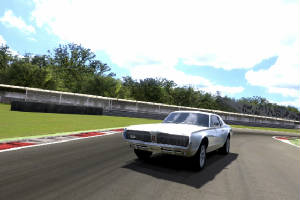
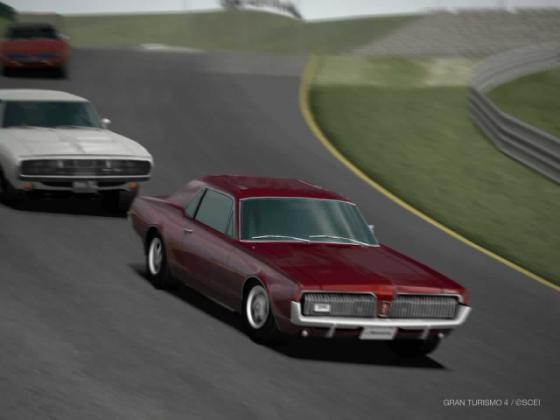
|
| Muscle Car Event at Sears Point |
------------------EXTERIOR-----------------
1967. 1967 was an exciting year for many reasons. One of which being 1967 was the year Mercury
joined Ford at the race tracks and showrooms with a brand-new mid-size coupe, the Cougar. There were two variations
(GT and XR-7), both of which were V8-powered (no straight-6 for these). The Cougar eventually earned Motor Trend's coveted "Car
of the Year" award during its first year of production.
Performance-wise, the Mustang is actually a better car than its cousin. It sold in much higher numbers,
started the pony-car war, yet oddly we don't have any '60s-era Ford Mustangs in any of our games. Mercury has
always been the more luxurious division of Ford, which translates to more weight. The XR-7 was Mercury's top-line Cougar,
more luxurious than the performance-upgraded GT models.
That being said, the XR-7 is still apperently a
great car in many ways. At $12,000 in GT2, it's a steal (GT4's price isn't much higher), and the variety
of colors it can be painted is mind-boggling. This includes several sexy 2-tone schemes. I literally sat in front
of my TV for over half an hour just trying to decide which color I wanted! Well, maybe not an entire half-an-hour.
The
Cougar followed the Mustang by 2½ years, but is still considered to be one of the earlier American muscle-cars. It is 190"
long and 71" wide, but also just 51.5" tall, which gives a nice center of gravity we can work with. Wheelbase is 111 inches--good
for stability, but this also makes the car difficult to maneuver at times in tighter areas.
In GT2, the Cougar is
especially heavy at 3,522 pounds, which I personally think is a typo. ...This led to a bit of research
on my part. And now I'm confused. www.conceptcarz.com pegs the 1967 Cougar at 3,004
pounds, but it doesn't say whether this is the weight of a GT or an XR-7. Wikipedia gives a range of 3,200 to 3,600
pounds, but this includes heavier 1969 and '70 models as well as lighter models from '67 and '68. In 1969, the Cougar went
thru some changes and got larger as a result. Basically, how much does this car really weigh? I couldn't get a straight
answer.
In GT4, the same car (1967 Cougar) weighs 3,125 pounds, which seems more accurate. At
the time I got the XR-7, I was rich enough that I could afford to take all its weight off (388 pounds),
which is highly recommended in GT2, but isn't typically necessary right away in GT4. Removing weight helps a lot, but
doesn't come close to solving the tendency for this car to understeer like a bloated mini-van at times.
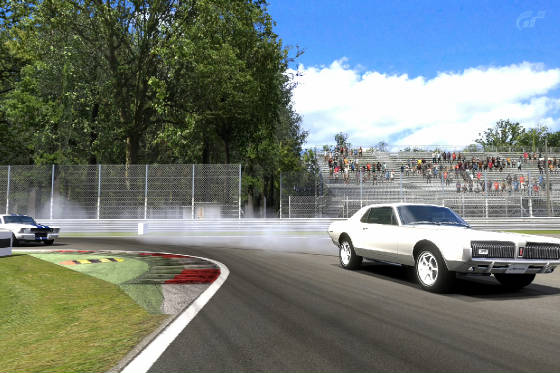
------------------ENGINE / DRIVETRAIN------------------
The Cougar's 390 cubic-inch 'big block' V8 is what muscle cars are famous for. In 1967, one had
a choice of small or big block engines (289 or 390 c.i.d.) for this model. Unfortunately, we don't get this choice in either
of the games the Cougar appears in. With a 4-barrel carburetor and beautifully deep idle, the engine is truly the heart of
this car, and it's part of what made these vehicles sell in record numbers during the '60s and early '70s.
The 390
makes the Cougar incredibly nose-heavy for circuit racing, but it has incredible acceleration: 0-60 in 5.6
seconds, 0-100 in 13.9; ¼ mile in 14.488 @ 101 mph and
0-1000 meters in 25.7 @ 133 mph. Those are all GT4 figures, but GT2 probably isn't much different.
At our tracks, this car does magnificently down straights and banked curves, but ask it to go thru a hair-pin with any
sort of speed gathered up and it won't like that at all! As I inferred, smaller block engines were available at the time
that the 390 was offered, and these were better with all around performance at circuit tracks, but they usually
lacked the rocket-like acceleration of the big blocks.
The good news is: with an engine like the 390, power modifications
are very secondary! You can easily focus on getting weight down and address other such problems before getting the
engine worked on, unless (of course) you're credit-rich. 377 foot-lbs. of torque easily pushes this car off
the starting line in no time. Remember that these bigger V8s have plenty of mid-range torque; shifting gears 500-1000 rpm
before the redline can actually help acceleration / speed. Torque (and speed) drop off dramatically once we get above
the 6,500 rpm redline.
The Cougar in GT2 has a 3-speed transmission, which may seem odd; but remember
that 5-speeds were only found in a few European and Japanese models at this time. Back in these days, one had a choice
of 3 or 4-speed manual trannys, or a 3-speed "SelectShift Merc-o-Matic". But in GT4, PD included a 4-speed. Oddly, the 3-speed
in GT2 is geared unrealistically tall; no muscle-car from the '60s (even the Corvette) would have been able
to make it to 153 mph as I did during the GT2 Max Speed test. At the test track in GT2,
the Cougar got up to about 140 mph, then struggled to make its 153.46 mph top speed. The
tach needle never clipped...never hit its 7,000 rpm limit; it's just totally out of steam once it gets running at these
higher revs! Therefore, it will hit an even higher speed (even while stock) if a racing gearbox is installed.
GT4's top speed of 123 mph is much lower, but also more in-step with the reality
of the times. There were a couple different axle ratios for the 390 engine...3.00:1 was standard, and a 3.25:1 "Power Transfer"
rear was optional, but it's hard to say how PD got their car geared high enough to make 153 mph in GT2. According to
this page:
2.40:1 1st gear
1.47:1 2nd gear
1.00:1 3rd gear
2.00:1 reverse
And there's no way a 3.00 or 3.25
axle ratio matched with a 1.00 3rd gear could make 153 mph. Doncha just love PD inconsistencies? ;-/
Dual or triple-plate clutches should also be utilized with the racing gearbox, depending
on how much power you're using. This car can be geared as tall as you'd like in many cases, it's got so much power that gearing
it short will just 'cause excessive wheel-spin, so set the gearing towards the 'wide' end (instead of 'sports'), and individual
gears can be set the way you'd like them.
Just remember to take advantage of that awesome 4 to 6,000 rpm area
down those straights. Three full levels of tuning and all the works take this cat up to 566 hp @ 5,600 rpm,
with 532 ft-lbs. of torque @ 5,100 in GT2, and that's about all it can really handle. The GT4 Cougar makes
a maximum of 661 BHP @ 4,800 rpms and 818 foot pounds!!! with Stage 3 NA tuning,
but can also be equipped with a supercharger, which belts out 524 BHP, and 800 foot-pounds.
Fer goodness sakes, Roscoe.
I recently raced an XR-7 at the Apricot Hill endurance race (GT2) against the mighty
GT40, and I won, but it takes great concentration. With all the power going to the rear wheels, spinning out is always a reality
to be aware of.
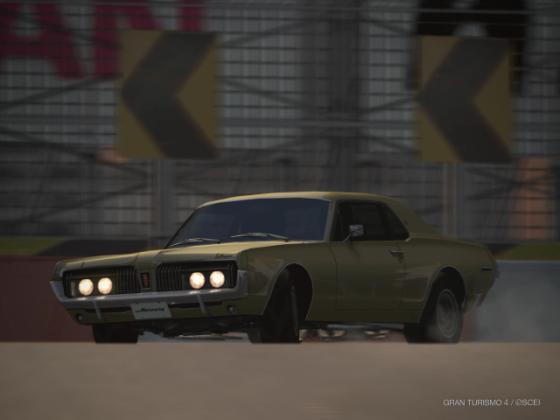
|
| ...drifting fun at Seattle. |
-------------------CHASSIS / HANDLING------------------
Cougars and other cars of the time often featured live rear axles with leaf springs, and
coils up front. This is basically the under-carriage you'd find in some trucks. These parts were the most durable option available during
this time before computer-controlled suspensions and traction-controlled drivetrains, but they can create a hell of a
ride when trying to corner.
The first thing you'll need to do when modifying this car (besides getting weight off)
is change the tires, preferably to sports or racing slicks (depends if you're playing GT2 or GT4. In GT4 the Cougar already
has medium sports when stock). The reason is: it's totally embarassing to race this car fully-modified, only to lose to a
modern econocar because the Cougar keeps spinning out like a mad bull! Street and sport tires are only good at the Test Track
and some of the easiest races. It's best to use slicks you're gonna compete in anything past the Sunday Cup series; otherwise,
way too much time may be spent trying to control this beast, and it won't be much fun to drive.
Your 2nd mod will obviously
be the suspension. Mercury apparently used soft springs for the XR-7 in an effort to make this car as luxurious as possible,
which makes me wonder how the GT version was configured. 2.1 kg/mm and 1.9 rear are comparable to figures we'd find in
a car that's 1,000 pounds lighter than the Cougar. Also, this car has almost 6½ inches of ground clearance.
I would go with the semi-racing or fully customized equipment to enhance this car's poor
handling. It'll never be perfect; and if you're going to race this car at a twisty track, be prepared for a lot of early braking.
A thorough knowledge for drifting will help a lot, too.
When approaching chicanes or hairpins, it's important
to be going to need to be going SLOW. Yes, the Cougar (and many other Americans from its time) has a racy look, but
the "raciest" moments this car will plunder are not to be found during cornering! Real-life Cougars had
drum brakes all around, making them prone to brake-fading. Well, Gran Turismo brakes don't fade, but they're not very good in this car. It's possible
to avoid this by getting in the habit of power-sliding when entering turns, which gets the car pointed in the right direction
(if you've got this sort of skill), but be really careful about getting back on the gas when exiting or the car'll end
up sliding merrily thru the clovers screaming plenty of words I can't print here! This is true of GT2 mostly, but GT4's Cougars
can also be tossed about with some success. GT5 The
main thing about the Cougar in Gran Turismo 5 is that once again, as we've seen with so many rear-drives, it'll be oversteer
that's much more of a dominating factor than the understeer of GT4. On the other hand, the way this car handles itself, over
bumps and getting positioned in and out of turns hasn't changed all that much. This is still a soft, sloppy sort of automobile,
as many other muscle cars are. You
don't really aim into turns in this one, so much that you aim and then fight. Fight the car itself, as it tries to
lose all kinds of grip and traction. Nothing really new we haven't seen in others. The Cougar (with its extra weight) hasn't
got the quicker reflexes of Mustangs, nor has it got the stability of some heavier muscle like Superbirds and Chevelles. It
does have the ability to win though. Work on that suspension, beef it up just like we did in earlier games, and this one can
compete just fine.
Real life cougars (the animal, not the car) are known for their agility and their instinct
to sneak around. Good luck trying to accomplish either with this cat!
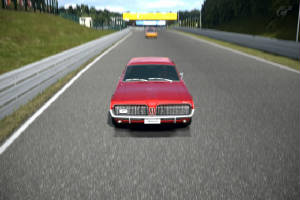
-------------------------PROS-------------------------
1). LOTS of power. Great acceleration.
2). This car has a 150+ mph (GT2) top-speed even though it was
produced during an era when most muscle-cars could barely top 130.
3). An overwhelming number of color schemes are
available.
4). Low price.
5). This engine growls like a carnivorous cat should.
-------------------------CONS-------------------------
1). Stock tires
can't handle anything but the ¼ mile. Throttle must be tamed at these moments, too. Typical muscle-car behavior from the '60s,
basically.
2). Soft springs create lots of swishy behaviour, making the Cougar hard to control before suspension mods.
3).
3-speed transmission comes standard (GT2). The 4-speed in GT4 is worse than the 3-speed in GT2!
4). Easily prone to
spin-outs, even when shod with racing slicks.
5). Heavy. Why can't we have the original (lighter) Mustang???
6).
Mushy brakes. This car is not for beginners (and intermediates who can't handle high-powered RWD vehicles).
7). No racing kit (GT2).

|


